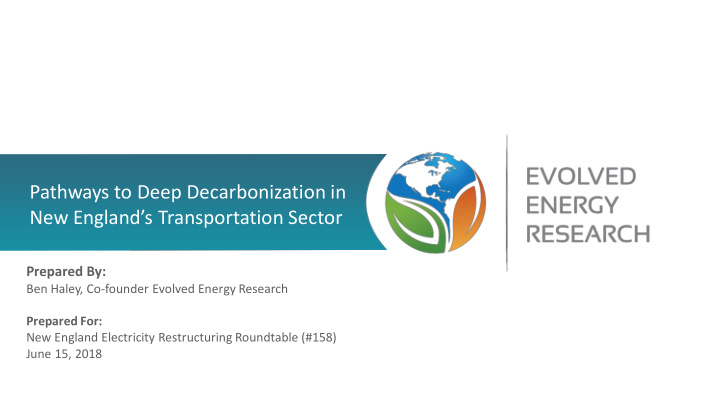



Pathways to Deep Decarbonization in New England’s Transportation Sector Prepared By: Ben Haley, Co-founder Evolved Energy Research Prepared For: New England Electricity Restructuring Roundtable (#158) June 15, 2018
Contents Deep decarbonization • defined Three pillars of deep • decarbonization Deep decarbonization of • New England’s transportation sector www.evolved.energy page 2
Definitions Deep Decarbonization: Transformation of the energy economy consistent with keeping global warming less than 2°C page 3
Definitions Pathway: Plan or blueprint to achieve deep decarbonization of the energy system page 4 4
Deep decarbonization pathways Charting a course for climate mitigation • Is deep decarbonization of the economy possible? • What parts s of the econom omy can be decarbonized? • What are the potent ntial pathw hways to do this? • What are the best st practices in navigating the path forward? page 5
Regional carbon emissions trajectories Pathways are based on analysis • from a recent report on achieving 2050 greenhouse gas goals in the 2017 Annual Energy Outlook U.S. Northeast conducted jointly with the Sustainable Development Solutions Network. Deep decarbonization pathway 80-85 percent below 1990 levels Williams, J.H., Jones, R., Kwok, G., and B. Haley, (2018). Deep Decarbonization in the Northeastern United States and Expanded Coordination with Hydro-Québec. A report of the Sustainable Development Solutions Network in cooperation with Evolved Energy Research and Hydro-Québec. April 8, 2018. page 6
Roadmap: three pillars of deep decarbonization New York & New England 2050 Benchmarks • 3x increase in the share of energy from electricity • 87% decrease in the emissions intensity of electricity generation • 40% drop in final energy use per capita (no drop in energy services) Electricity share of end use Carbon emissions per unit of Annual per capital energy use energy consumption (%) electricity (kg CO2/MWh) (MMBtu/person) http://unsdsn.org/wp-content/uploads/2018/04/2018.04.05-Northeast-Deep-Decarbonization-Pathways-Study-Final.pdf page 7
Three pillars New England Transportation Pillar: Electrification Pillar: Energy Efficiency Pillar: Electricity Decarbonization Transition vehicles on the road from gasoline- 50 percent decrease in energy consumption Charging electric vehicles on a low carbon powered internal combustion engine to battery due to efficient electric powertrains and high electricity grid decreases overall electric and plug-in hybrid electric vehicles efficiency internal combustion engines. transportation emissions by 80 percent where possible. 98% -50% -80% http://unsdsn.org/wp-content/uploads/2018/04/2018.04.05-Northeast-Deep-Decarbonization-Pathways-Study-Final.pdf page 8
Light duty vehicle benchmarks New England http://unsdsn.org/wp-content/uploads/2018/04/2018.04.05-Northeast-Deep-Decarbonization-Pathways-Study-Final.pdf page 9
Transportation stock across vehicle weights New England http://unsdsn.org/wp-content/uploads/2018/04/2018.04.05-Northeast-Deep-Decarbonization-Pathways-Study-Final.pdf page 10
Notes on autonomous vehicles Analysis by EER for 2016 Risky Business report (U.S. wide analysis) • Autonomous vehicles, Vehicle electrification can also especially those that are be accomplished by fewer used for shared mobility, have higher utilization. electric vehicles driving more Light-Duty Vehicle Miles Traveled Operational savings from an electric vehicle lead to more favorable economics than ICEs • Accelerates turnover and achievement of the electrification pillar • Achieving electricity Because of the savings decarbonization means in transport, total deep any concurrent increase decarbonization net costs can be negative in VMTs has little impact Energy-Related on overall carbon CO 2 Emissions emissions Incremental Energy System Costs • AEVs reduce overall costs of transportation page 11
Final thoughts: Three Pillars Questions New England Transportation Electrification Energy Efficiency Electricity Decarbonization What is the right level of How can electrified How do we accelerate transportation address efficiency as we transition consumer adoption of to zero-carbon energy electricity balancing electric technology? How supplies? challenges inherent in low- will autonomous vehicles carbon electricity systems? change the picture? How does demand reduction fit into this pillar? Will load growth from What strategies can we electrifying transportation pursue in areas where mean the region exceeds electrification isn’t available renewable possible? resources? page 12
THANK YOU (844) 566‐1366 info@evolved.energy www.evolved.energy 2443 Fillmore Street, No. 380‐5034 San Francisco, CA, 94115
Three Pillars in Practice United States 2050 U.S. Benchmarks 2x increase in the • share of energy from electricity or electrically derived fuels ~99% decrease in the • emissions intensity of electricity generation 3x drop in energy use • per unit GDP www.evolved.energy page 14
Three Pillars in Practice China, India and United Kingdom China India UK Source : figures from Deep Decarbonization Pathways Project country reports (2015) www.evolved.energy page 15
Three Pillars of Deep Decarbonization • Breadth of analyses conducted has given us a good basis to draw some high-level conclusions about what a deeply decarbonized energy system must include • We call these the Three Pillar ars and they are: 1. 1. Electr trifi fica cation: n: Switching to electricity as final energy product for some end-uses (i.e. electric vehicles). 2. 2. Energy Effici ciency ncy: Using less energy to perform the same energy service (i.e. LED lightbulbs provide the same lighting service with less electricity) 3. 3. Electr trici city y Decarboni nization: n: Generating more energy from clean and renewable sources and less from fossil fuels www.evolved.energy page 16
Recommend
More recommend